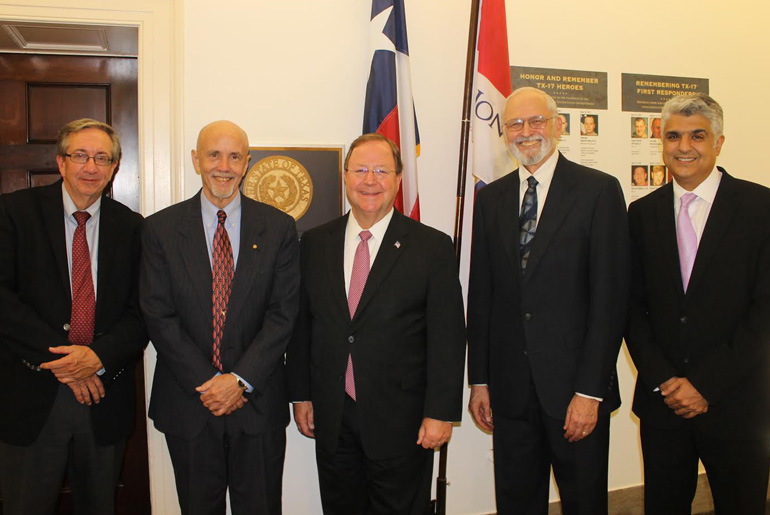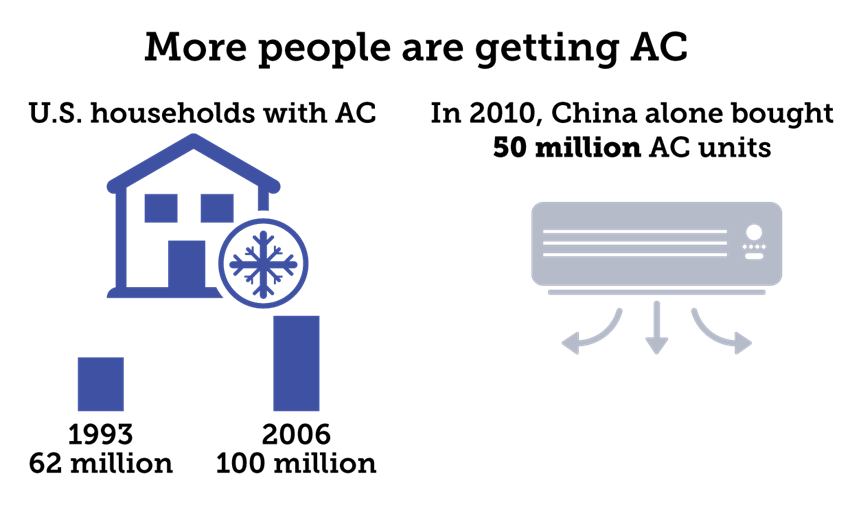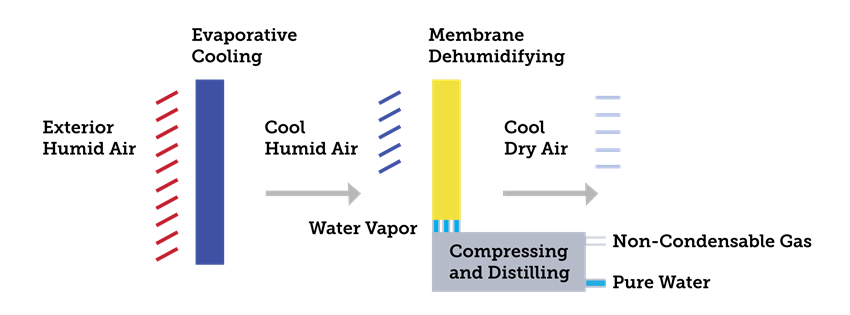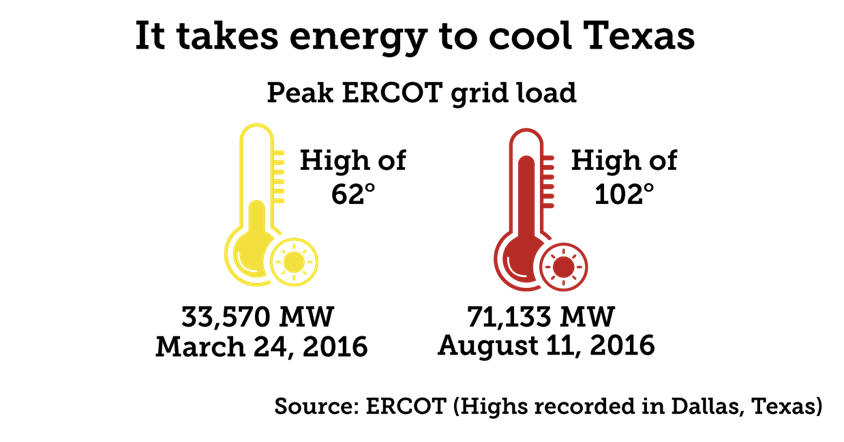
To explain the potential energy impact for their air conditioning technology, Texas A&M Engineering Experiment Station (TEES) researchers Dr. David Claridge and Dr. Charles Culp draw a parallel to the auto industry.
“If we were still using vehicles that used as much gas as they did in the early 1970s compared to what we’re doing today, the additional oil that we would need would just about double the oil imports in this country,” said Claridge, who is director of TEES’ Energy Systems Laboratory and the Leland T. Jordan Professor in the Department of Mechanical Engineering at Texas A&M University.
“The air conditioning business right now is about a $100 billion a year,” added Culp, who is a professor with the Department of Architecture and a joint faculty member with mechanical engineering. “By 2025, it’s projected to be about $200 billion. That energy use is going to double. What if we can come up with something that uses half the energy or less? If you look at where the population is growing, it’s all around the tropic belt, in the hot and humid climates, and our air conditioner loves hot and humid climates.” 
A new approach to an old technology
Evaporative cooling is a known technology with benefits over conventional air conditioning systems, the biggest of which is it does not use refrigerants and is very efficient. But it’s a technology with geographic limits because it requires dry air. Claridge and Culp believe they’ve found a way to remove that limitation.
Simply put, evaporative cooling adds water to the air, and the evaporation of that water cools the air around it. However, adding more water to the air is a problem in high humidity climates.
“In a climate like this, the air is so humid that there’s no way you want it to get more humid even if it does get a little bit cooler,” said Claridge. “Basically, the technology we’ve developed is something that enables you to efficiently remove enough moisture from the air so that you can then go ahead and use this evaporative cooling technique to get the air colder.”
Though they’re now closing in on their goal of creating a prototype system, it’s been a long journey since they first thought up the idea.
“We are basically two physicists and we started thinking about how we could come up with a more efficient air conditioner,” Culp said. “A 50 percent or even two times more efficient air conditioner. Because air conditioning takes a tremendous amount of energy.”
Their inspiration came from James Clerk Maxwell’s famous physics thought experiment called Maxwell’s demon. In it, Maxwell imagined a tiny demon that could open and close a small door between two chambers of gas, separating out the fast moving particles from the slower ones, causing the chamber of slower molecules to lower in temperature while the chamber of faster ones rises.
“We thought, maybe we can do something like that with water vapor,” Claridge said.
Their solution didn’t come overnight, and though it isn’t a demon, it does work on a very small scale.
“We had years of failure,” said Claridge. “We tried all kinds of crazy things. About six years ago, we had a breakthrough. Someone else came up with a molecular material that passes water vapor, but only a tiny bit of air.”
Using this molecular membrane, their system solves the humidity problem by removing water molecules from the air after the air is cooled, producing cool dry air and pure water. In wet climates, the ability to control the humidity without changing the temperature of the air is also a benefit of the system.

“Think about those mornings this time of year that maybe it’s 70 degrees outside but there’s condensation on the windows,” Claridge said. “The house doesn’t need to be colder, but it’s sticky. This technology allows you to dry the house sufficiently to make it comfortable at normal temperatures.”
TEES’ Office of Commercialization and Entrepreneurship encouraged the two to form a company in 2015, which they named simply Claridge-Culp, and has guided them from a business standpoint. For example, TEES encouraged them to find a CEO with ties to the industry, and they found the perfect person for the job in Damon Gowan, Aggie class of 1958, a self-made executive who built the largest mechanical contracting business in Houston and is a former president of the American Society for Heating, Refrigerating and Air-conditioning Engineers (ASHRAE.)
“A big thing for us is that a number of people who work for TEES have been superior at giving advice on things that neither one of us had any experience working with,” Culp said. “They’ve also put us in contact with other small companies, and we have a lot of shared experiences. Just sharing little bits of guidance makes a big difference.”
There has already been early interest in the technology. Claridge-Culp was selected as one of the “Best University Startups” by the National Council of Entrepreneurial Tech Transfer (NCET2). Theirs was one of 35 university startups selected to present their company pitches in Washington, D.C. on Sept. 20 at the inaugural University Startups Demo Day.
Pushing Technological Limits
Last year they proved that the science behind the system works. Now they just have to engineer it. They’re aiming to have a prototype system built and tested by 2018.
“We’re addressing all those myriad engineering problems,” said Culp. “Cost, size, weight -- you can just go down the list. But we know it works.”
The biggest hurdle to cross is the overall efficiency of the system. They know that industry will be unlikely to adopt their system unless the cost is competitive with conventional air conditioning. To do that, they’re pushing the limits of technology in several areas.
Take the compressor, for example. In conventional air conditioners, the refrigerant is compressed to high pressures, usually over 250 pounds per square inch. In Claridge-Culp’s approach, the compressors are faced with totally different requirements as they only need to compress about 1.5 pounds per square inch but with a higher flow.
“Basically the devices they use are in the general classification of vacuum pumps, they’re generally not worried about the efficiency,” Culp said. “The first compressors we used in the early prototype had an efficiency of less than 5 percent and we need something in the range of at least 60 percent to have a practical device. We’re working with a company in Colorado to use a different type of technology to build a compressor that looks like it should get us into the 65 percent range.”
Global Implications
According to the U.S. Department of Energy, 6 percent of the average American household’s annual energy use is space cooling. In Texas, that number is even higher. According to the Electric Reliability Council of Texas (ERCOT) the record peak demand was 71,093 megawatts on August 11 of this year. That’s 30.5 percent higher than the expected peak demand in autumn, and 21.3 percent higher than expected peak demand in winter.


Combine that with the fact that 76.4 percent of Texas’ power is generated from fossil fuels (48.3 percent from natural gas and 28.1 percent from coal) and you can already see the potential impact of more efficient cooling.
“I believe, whatever the time frame, we’re going to be running out of fossil fuels,” Claridge said. “I personally believe burning fossil fuels unnecessarily is pretty harmful in terms of what it’s doing to climate change. Fundamentally it looks like this idea is one that will make air conditioning work better and more comfortably. And it will do less harm to the environment than the way the current refrigerant systems do, and it should do it at less cost. That’s something I think is pretty exciting.”
While their team continues to solve the complicated engineering challenges to address the ‘how’ of their system, Claridge said the ‘why’ remains unchanged from when they started.
“To change the world,” he said.
Photo: Claridge-Culp at University Startups Demo Day in Washington, D.C. From left to right: Mark Andrews, manager, contract negotiation (TEES); Culp; U.S. Rep. Bill Flores; Claridge; Dr. Balakrishna Haridas, executive director for technology commercialization and entrepreneurship (TEES).
